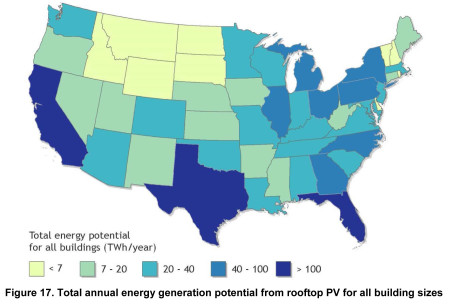The National Renewable Energy Laboratory (NREL) just released a study that shows that the United States can provide about 40 percent of its electricity needs via rooftop solar (PV – photovoltaics).
A new study showed a potential of 1,118 gigawatts compared to an estimate from 2008 that only showed 664 gigawatts of potential solar electricity. The new revised estimate is almost twice as much for two reasons; improved knowledge of building suitability and increased solar panel efficiency over the past 8 years.
Robert Margolis, NREL senior energy analyst has stated that “This report is the culmination of a three-year research effort and represents a significant advancement in our understanding of the potential for rooftop PV to contribute to meeting U.S. electricity demand.”

A total of 128 cities were analyzed by the NREL. This sample size represents about 25 percent of the total amount of buildings in the country. Not surprisingly, a city in California topped the PV suitability list. Overall, the state could provide 74 percent of its electricity sales via rooftop PV. However, Concord, New Hampshire and Buffalo, New York also were found near the top of the list.
This study can be seen as further proof that solar’s potential is truly astounding. The 40 percent figure only takes into account PV solar and only on rooftops. Carports, ground mounts, and utility scale solar was not included.
As far as other forms of solar are concerned, it’s not an either or debate. Margolis has stated that “There’s been a lot of debate about whether large-scale solar is a solution versus rooftop solar. There’s a lot of technical potential for rooftops and for large-scale solar – both have roles to play.”
Perhaps the most important idea related to this report is that rooftop solar represents the democratization of energy. Distributed generation puts more power and money into the hands of those who use it. This is the true value of solar power.
It might be easy to underestimate this 40 percent figure, but in terms of electricity costs, we’re talking about many billions of dollars going into the pockets of homeowners and business owners all across the country. Of course, utilities will continue to invest into large-scale solar and even offer their own PV programs for residential and commercial use.
The big picture here is that this is yet another example of the vast untapped potential for solar power. The combined potential of utility-scale solar with its distributed generation rooftop pv can more than provide for all of our collective energy needs.


In conclusion, rooftop solar has the potential to significantly contribute to the US electricity supply by providing around 40 percent of the total demand. This renewable energy source offers numerous benefits, including reduced greenhouse gas emissions and increased energy independence. However, to fully harness its potential, it is crucial to address challenges such as cost, infrastructure requirements, and policy support. With continued advancements and support, rooftop solar can play a vital role in transitioning towards a more sustainable and clean energy future for the United States.
In conclusion, rooftop solar has the potential to significantly contribute to the US electricity grid, providing approximately 40 percent of the country’s electricity needs. This renewable energy source offers numerous benefits, including reducing greenhouse gas emissions, enhancing energy independence, and creating job opportunities. With continued advancements in technology and supportive policies, rooftop solar can play a crucial role in transitioning towards a more sustainable and clean energy future.
In conclusion, rooftop solar has the potential to significantly contribute to the US electricity supply, with the ability to provide approximately 40 percent of the country’s energy needs. This renewable energy source offers numerous benefits, including reduced reliance on fossil fuels, lower greenhouse gas emissions, and increased energy independence. As technology continues to advance and costs decrease, rooftop solar has the potential to play an even more significant role in the future of the US energy sector.
In conclusion, rooftop solar has the potential to significantly contribute to the US electricity supply, accounting for approximately 40 percent. This renewable energy source offers numerous benefits including reduced carbon emissions, energy independence, and cost savings. With further advancements in technology and increased adoption, rooftop solar has the capacity to revolutionize the energy landscape and pave the way towards a more sustainable future.